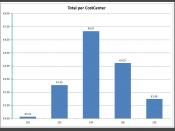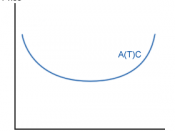This memo is a suggested cost structure regarding to the contract with Montana Power. After my
calculation, I discovered the perfect cost structure is to generate some power internally and buy
some power externally, with 190 megawatts (rounded) generated from PPL's hydro facilities in
Montana, 87 megawatts (rounded) generated from PPL's J.E. Corette Plant, as well as buying
223 megawatts (rounded) from other generators in the spot market.
After analyzing the total cost structure in figure 1, I saw that at a specific point, such as around
200, the cost of both PPL's hydro facilities' cost increase significantly. Though PPL's hydro
facility and Corette plant had more than enough capacity to meet the 500 megawatt capacity,
producing all power internally will lead to a significant increase in total cost. So John
Chamberlain could be wrong about refusing to buy power from spot market.
The method I used was a Lagrangian analysis of the total cost base on the cost function
Rodriguez provided, assuming her cost estimates were right. First of all, I combined the total cost
equation,
ðð¶ = 1000 + 0.09ð¥2 + 0.15ð¦2 + 6ð¦ + 0.02ð¥ð¦ + 36ð§, subject to ð¥ + ð¦ + ð§ = 500, ð¥ <
476, ð¦ < 227.
Because we didn't want to fail the contract as well as waste any power. In order to get the
minimum total cost, I set up a Lagrangian function:
ð¿ðð¶ = 1000 + 0.09ð¥ 2 + 0.15ð¦2 + 6ð¦ + 0.02ð¥ð¦ + 36ð§ + ð¾(ð¥ + ð¦ + ð§ â 500),
ð¤âððð ð¥ < 476, ð¦ < 227.
Then the best combination is ð¥ = 190.30, ð¦ = 87.31, ð§ = 222.39, ð¾ = â36, where the total cost
is minimum at $14264.93. The result matches perfectly with the one I...


